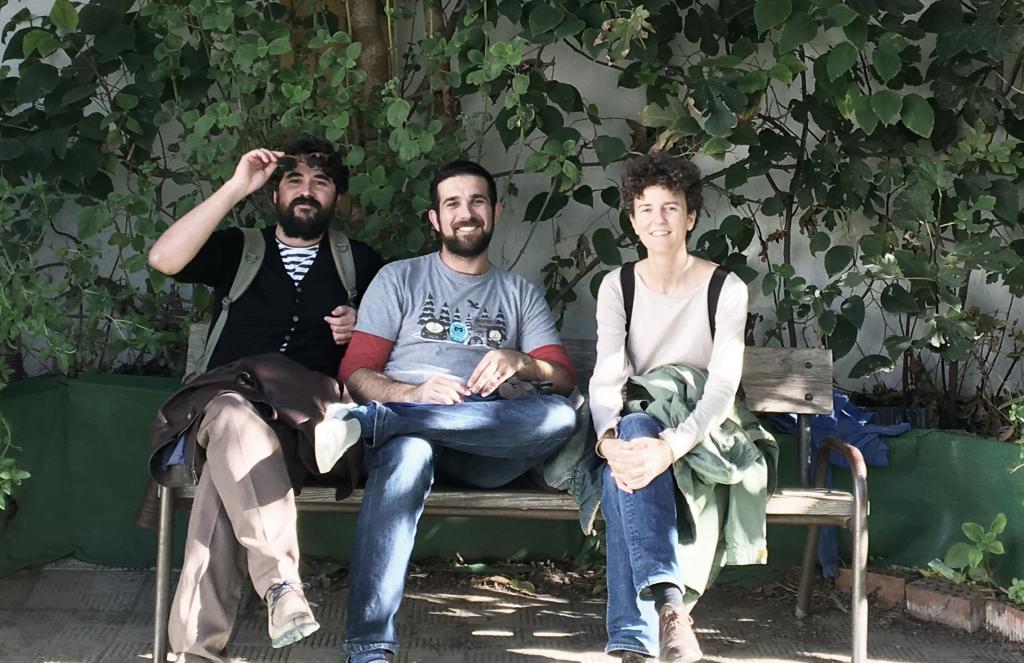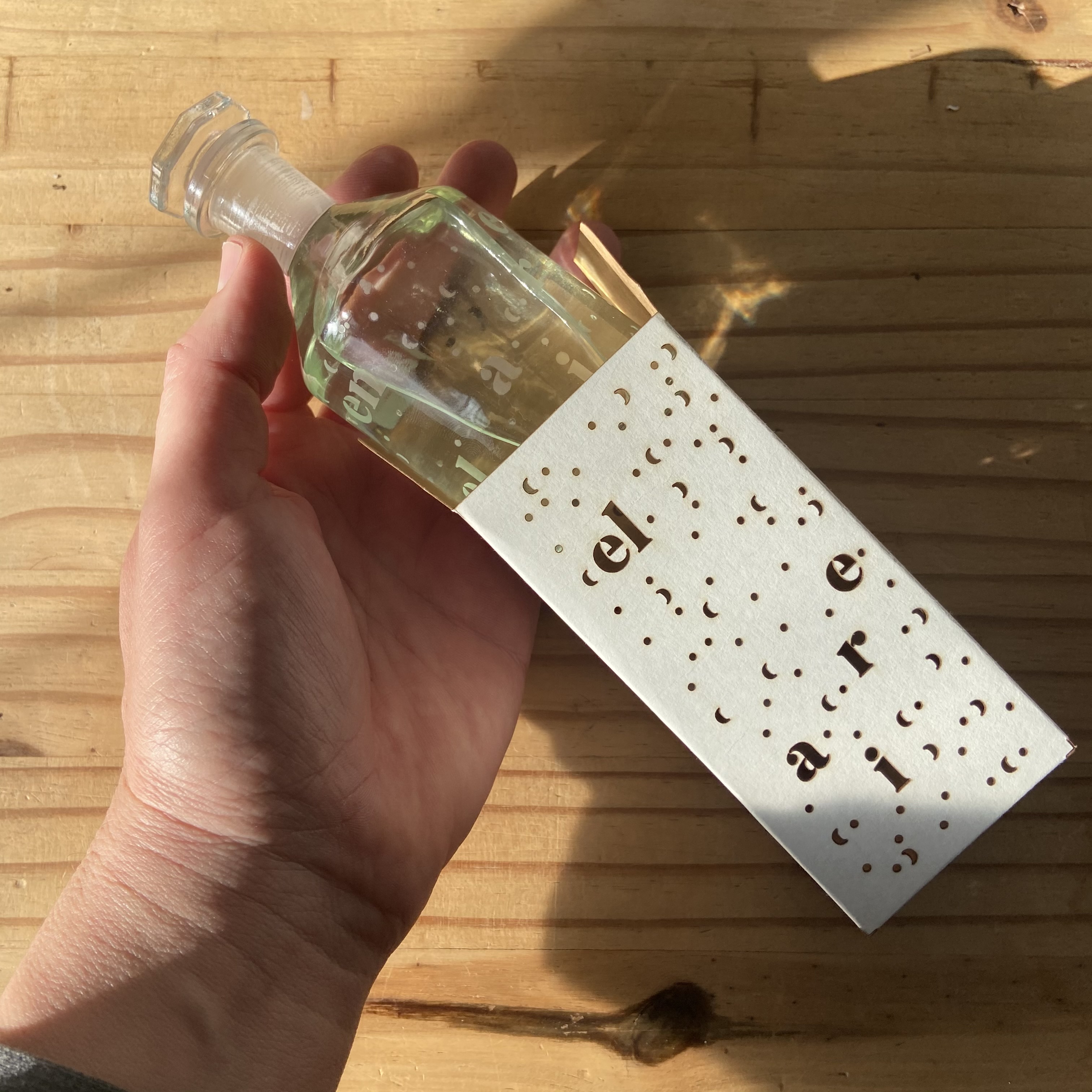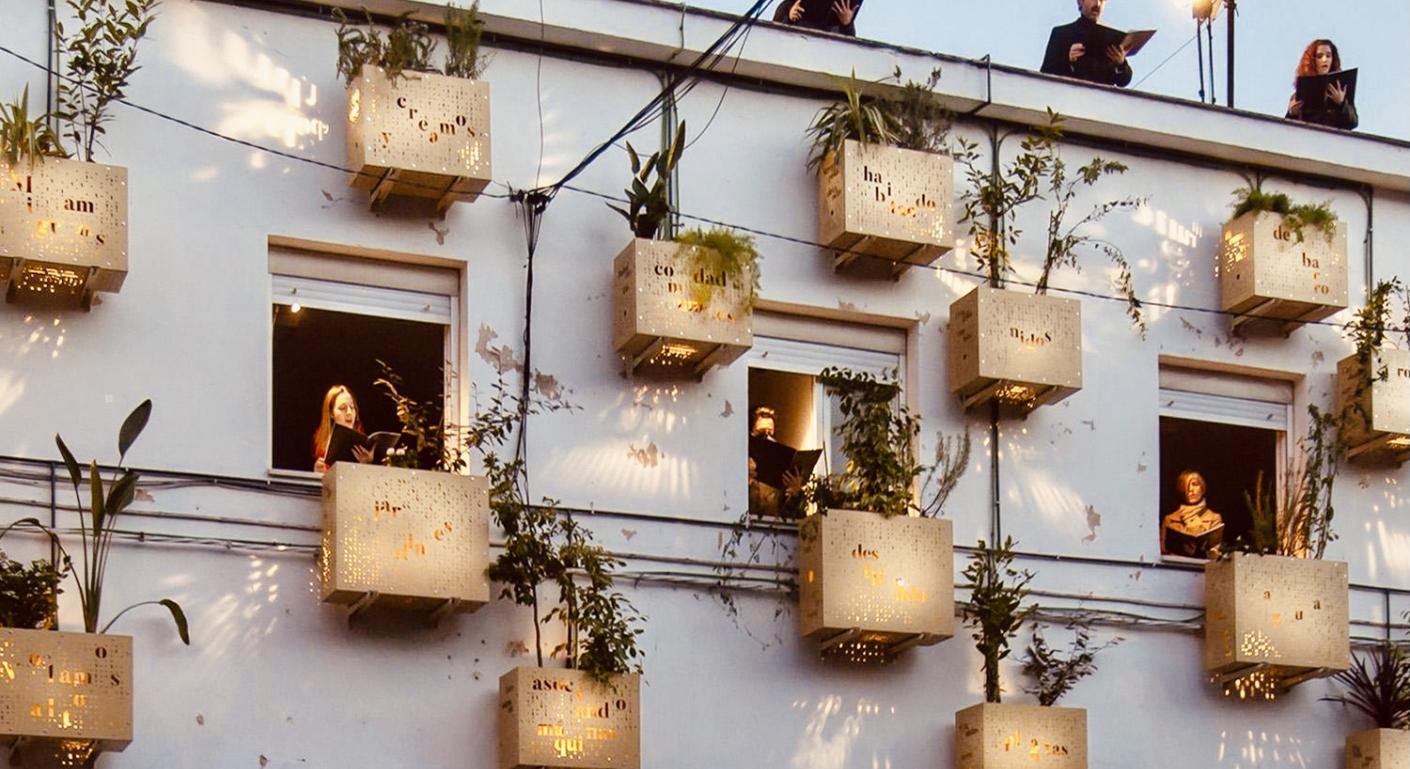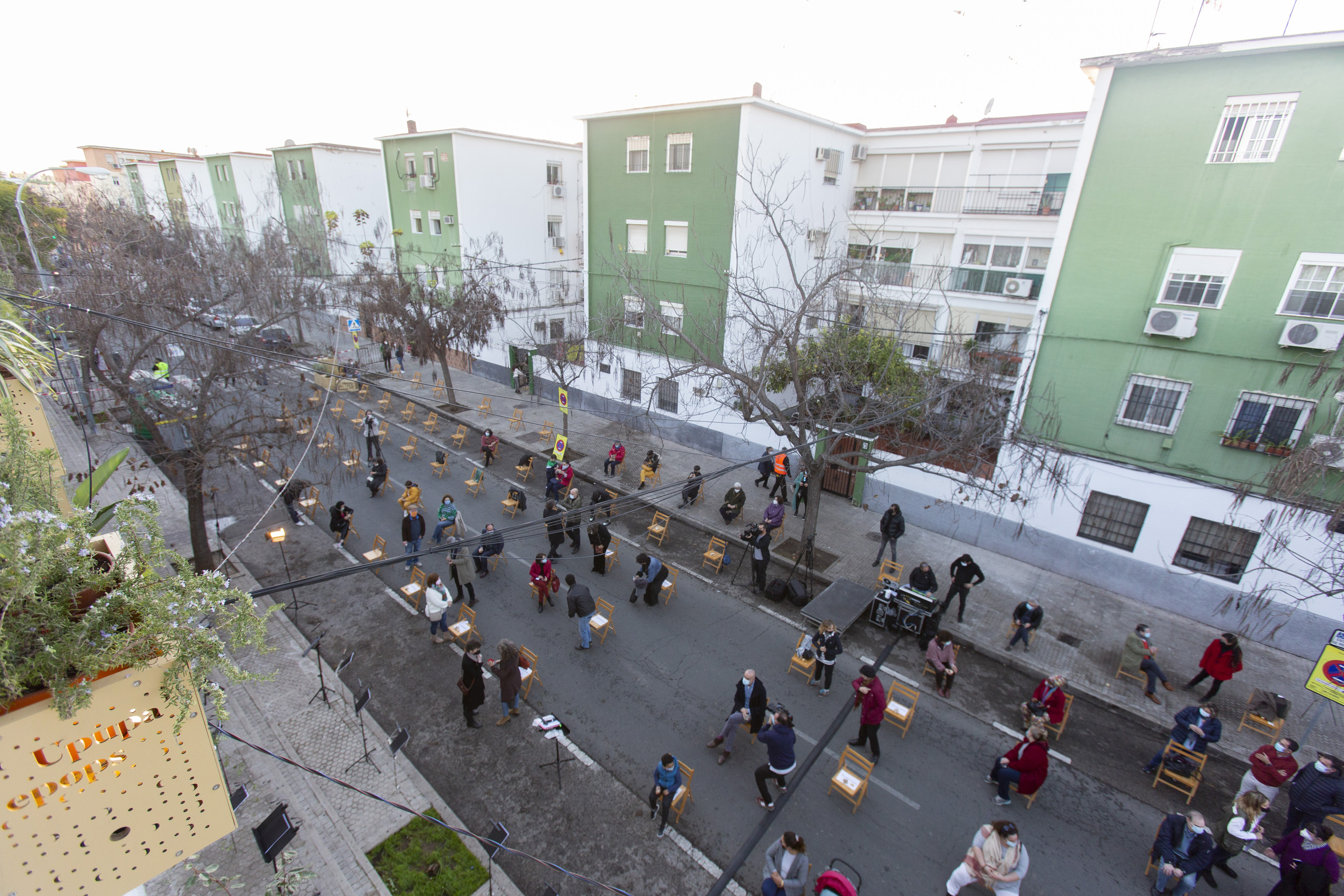Thessaloniki gets ready for its metro launch in November
The underground rapid transit lines have been under construction for almost two decades due to various project delays
 TheMayor.EU logo
TheMayor.EU logo 
Nomad Garden is the team of landscape experts behind the successful ¨Gardens in the Air¨ project, Source: Nomad Garden
An interview with the Seville team behind the NEB Prize-winning project “Gardens in the Air”
Recently, we spoke to Nomad Garden, the multi-disciplinary landscape architectural collective behind the NEB Prize-winning project “Gardens in the Air” in Seville. In a way, it’s a return to the roots, since that Spanish city was where the New European Bauhaus initiative was first presented. The answers provided here are by Salas Mendoza Muro, Francisco José Pazos and Sergio Rodríguez.
It is a circular initiative of urban renaturalization, encouraged by the Seville City Council and Ecosystem 41, in which artists, scientists, architects, designers, young students and residents of Tres Barrios-Amate district in Seville participate together with local associations, such as A.E.S. Candlemas.
It is a project that has been maturing through two years of workshops, meetings and shared celebrations, with the aim of exploring resources and plants that already exist in the neighbourhood with the aim of imagining new relationships between them, as well as strategies that allow them to prosper in balance, generating a more habitable environment for all.
The initiative has finally materialized in three complementary works:
There are multiple communities and “publics” involved in this project. Precisely, one of its initial objectives was to identify the existing human and non-human communities in Tres Barrios - Amate, one of the most deprived areas of the city but also the most diverse and cosmopolitan, with the aim of starting to work from its potential.
Another objective was to take science out of laboratories and the arts out of museums or theatres, and to involve them directly in projects of urban transformation together with communities outside these fields. In this way, local communities had the opportunity to explore their daily reality and rethink solutions based on it through the capacity of the arts and sciences.
We work with the Educational Association of La Candelaria, an exemplary institution in the neighbourhood that serves more than 400 boys and girls from different nationalities. Specifically, the work was carried out with a stable group of 20 boys and girls, later expanding the workshops to their families.
Although the research, creation and prototyping laboratories were carried out for two years with this small group, their results were conceived as works that should conclude with cultural celebrations in the public space that would allow the production to be shared with the residents of the neighbourhood and the city. Thus, more than 1,000 people participated in the different exhibitions and concerts, and more than 30,000 have visited or passed through the Candelilla street garden.
Apart from this direct impact, the project has achieved local, national and international recognition that has made a neighbourhood, usually associated with negative news, proud. In this way, those positives that exist in the environment and that can serve as a lever and impulse have also been valued. And we are not only referring to those relevant people and associations in the neighbourhood, but also to its vegetation and the unique birdlife that also lives here.
We are firmly convinced that a garden is a laboratory of coexistence, where humans and non-humans interact to create more diverse, rich and resilient environments. When public space is conceived as a garden, the accent is being placed on the other actors that accompany us in the cities.
Precisely with this aspiration, the reuse of water from air conditioners (normally discarded) has been proposed as working material to create a more biodiverse environment, where plants and animals coexist with people while exploring green thermal mitigation strategies and renaturation. Furthermore, processes in which the community is involved in the entire process and in the construction itself, also reusing its own imaginary and the diversity of languages of the neighbourhood communities.
The “Gardens in the Air” perfume, designed by Barnabé Fillion for the project, is also a very powerful tool to recognize vegetation as a member of your vital ecosystem. Urban vegetation is also a diverse and cosmopolitan community, made up of migrants from all over the planet who have taken root and co-evolved here in search of resilience.

One of the 333 flasks of perfume that collect the essence of the neighbourhood. Source: Garden Atlas.
The perfume collects the essences of the environment itself, the neighbourhood, the aromatic species present, focusing on the fact that the most important aromatic notes (incense, rose, pink pepper, bitter orange, cedar, rosemary, eucalyptus) come from all continents, proudly representing the aroma of one of the most cosmopolitan neighbourhoods in the city.
Lastly, and as a synesthetic reflection of the garden and the perfume, the young composer Desirée Martín created a polyphony that explores the multiplicity of voices - human and non-human - that make up the peripheral neighbourhood of Tres Barrios-Amate. For this, she had the collaboration in the fieldwork of Antropoloops, Vibra-tó, Amigos del Parque Amate and Seo Birdlife, and with the direction and interpretation of Carlos Cansino and Proyecto ele.
On a rational plane, the work celebrates the links and associations between the different communities of people, plants and birds in the neighbourhood. On a sensory level, the work invokes other states, other ways of being… recognizing in its babbling a heteroclite assemblage of mysteriously attuned languages. An altogether different way to bond.

The polyphony presented with the vertical garden serving as the stage. Source: New European Bauhaus Prize Winners
First, and perhaps most importantly, for the entire community it has been a source of pride, as was said before. Not only for the active participants but for the entire neighbourhood. The residents have seen this story on the front page in the press and media from all over the continent, and it speaks of Tres Barrios-Amate as an innovative, sustainable, rich and creative place. It is a way of recognizing that we are all useful, that important things are also happening there for others and from which we can learn (and teach) the rest of the world.
It has also been a help for other institutions to observe the project more seriously, with a background that goes beyond the anecdotal or celebratory, and that seeks and aspires to transform reality effectively.
It has also served so that people from other places in Seville, and even from outside, have gone to visit this corner of the city to see it with new eyes. That thing that happened in a humble street in a neighbourhood on the outskirts of southern Europe is held up as an example of a participatory, inclusive, sustainable and innovative project at an international level. It means that everything is possible, and we must not stop trying.

A street in Tres Barrios-Amate where the project was presented. Source: Garden Atlas
On an economic level, which is also important, it has allowed us to give a new impetus to the program of workshops and activities, giving continuity to the project and incorporating new actors, both from the community itself and from outside.
Seville is well known for its hot and dry summers, and months of pronounced water deficit. A large part of the buildings, public and private, fill their facades with air conditioning machines that end up forming puddles in the streets when the heat and drought hit harder. These form unexpected oases used by plants, birds and other beings that resort to them to survive.
On the other hand, Seville has a long tradition of tools and methods of fighting against the rigours of summer. Many of them are local passive strategies, such as the use of ceramic pots that serve both to improve the environment at a microclimatic level, as well as to beautify and leave space for other living beings. Others are more global, such as the use of mashrabiyas, lattices of Moorish origin that allow the windows and facades of buildings to be improved with shading and drafts.
Likewise, we were aware that this context is not unique, and that the solutions and strategies tested here will be replicable and extrapolated to many other urban contexts. Especially in the face of the challenges of climate change, which will aggravate and extend the problem.
The economic, social and cultural contexts are also quite interesting. Not only because it is in a "depressed" neighbourhood, but also because of the absence or scarcity of contemporary cultural and scientific actions that should accompany, and not compete, with the necessary social aid. The need for the latter cannot be a reason to abandon the former.
Culture is the first-order necessity, and even more so when it is accompanied by the opportunity to try, discover and learn about new tools, technologies or activities that go beyond the existing offer, which often falls into only the urgent (the now), forgetting what is important (the future).
Tres Barrios-Amate is also one of the most cosmopolitan areas of Seville. Not only on a social level, because of the origins and cultures of its human inhabitants, but also due to the existence of a diverse and rich avifauna, which together with the green space that the Amate Park represents and a tree-lined street. (The streets of the neighbourhood are home to one of the most important concentrations of bitter orange trees in Seville). The same goes for the intense use of public space. Partly due to poor building quality, but also due to the strength of the community support networks, both associative and human, that make the street, squares and other spaces of coexistence, fundamental nodes of the daily life of its inhabitants.
Derived from this coexistence intensity, opportunities arise, such as that of the AES Candelaria, a social and educational association that has been working and helping children from the neighbourhood for more than 40 years. It has been teaching them to live together, to work together, to take care of themselves and look after each other. They were the first inspiration for this project.
We think so, because of everything we have already said (replicability, climate challenge, emerging learning, etc.), and also because the project has also been set up as an experiment. A prototype both at a procedural and technological level, which allows us to test and validate the hypotheses launched.
From this perspective, the sensorization of the garden is the best example. It is not just a matter of incorporating home automation to manage irrigation, but also of obtaining data that allows us to learn about the effects of the garden at the climate level, and at the levels of water and energy savings. It’s about discovering what the real impact of these strategies is: how much water we can recover, how we can use it to greenify our cities, how we can distribute it through our architecture to mitigate temperatures, to increase biodiversity and promote more beautiful environments is our main objective now.
We are also trying to analyze the feasibility of turning the remains of the pruning done every year on urban vegetation into a resource. To this end, a laboratory has been created in the neighbourhood (carried out with donations for the perfume and the help of Thermo Fisher Scientific). Likewise, workshops for the distillation of essential oils and natural cosmetics have begun to be developed in the neighbourhood.
In this way, we begin to partially close the circle hinted at at the beginning of the project, and that encourages us to rethink other ways of considering and managing our plant resources in the city.
In any case, we believe that it is not just a matter of making an idea sustainable over time, or of making it replicable, but also of offering experiences, or sowing seeds that can germinate in the future in conditions and situations far removed from any planning.

The underground rapid transit lines have been under construction for almost two decades due to various project delays

Now you can get your wine in Talence by paying directly in Bitcoin

That’s because the state has to spend money on updating the railway infrastructure rather than subsidizing the cost of the popular pass

Rethinking renewable energy sources for the urban landscape

The examples, compiled by Beyond Fossil Fuels, can inform and inspire communities and entrepreneurs that still feel trepidation at the prospect of energy transition

Now you can get your wine in Talence by paying directly in Bitcoin

The 10th European Conference on Sustainable Cities and Towns (ESCT) sets the stage for stronger cooperation between the EU, national and local level to fast track Europe's transition to climate neutrality.

At least, that’s the promise made by the mayor of Paris, Anne Hidalgo

The underground rapid transit lines have been under construction for almost two decades due to various project delays

At least, that’s the promise made by the mayor of Paris, Anne Hidalgo

Hostal de Pinós is located in the geographical centre of the autonomous region

Despite its church-y name, the district has long been known as the hangout spot for the artsy crowds

Urban dwellers across the EU are having a say in making their surroundings friendlier to people and the environment.

Forests in the EU can help green the European construction industry and bolster a continent-wide push for architectural improvements.

Apply by 10 November and do your part for the transformation of European public spaces

An interview with the Mayor of a Polish city that seeks to reinvent itself

An interview with the newly elected ICLEI President and Mayor of Malmö

A conversation with the Mayor of Lisbon about the spirit and dimensions of innovation present in the Portuguese capital














